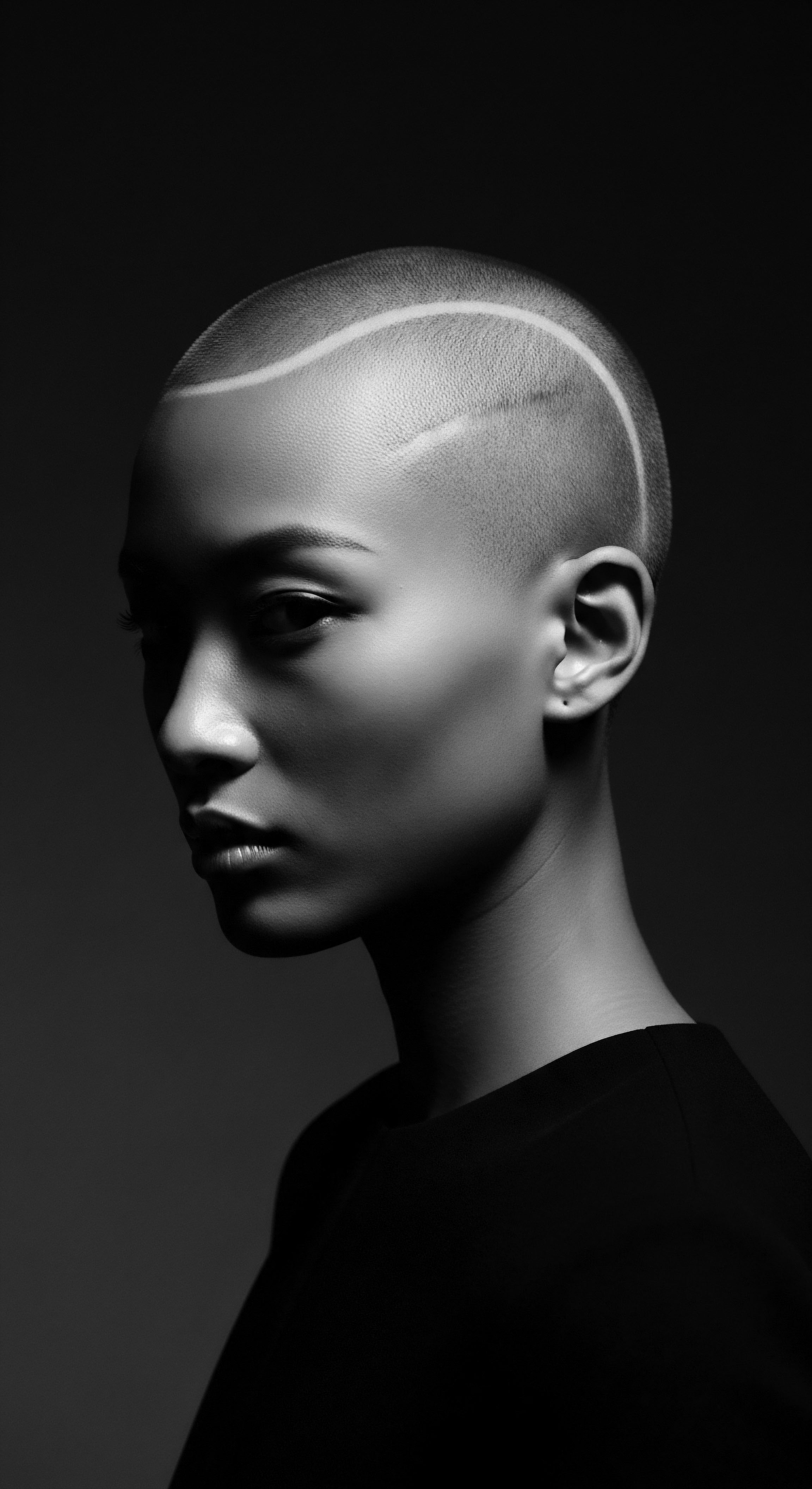
Fundamentals
The Hair Cleansing Rites represent more than a simple act of washing; they stand as a deeply rooted tradition, a sequence of intentional practices aimed at purifying the hair and scalp. At its most straightforward interpretation, this delineation speaks to the process of freeing hair from accumulated environmental elements, product residues, and natural oils. It refers to the systematic approach individuals employ to refresh their strands, setting the stage for subsequent care and adornment. This foundational understanding acknowledges the elemental requirement for cleanliness, providing a refreshed state for the scalp’s ecosystem and the hair fiber itself.
Consider the meaning held within these practices. They encompass the very concept of renewal, a physical and energetic release of the day’s, week’s, or season’s burdens. For those new to appreciating textured hair, grasping this initial explanation of Hair Cleansing Rites helps clarify that care transcends mere superficial engagement; it involves a deliberate, restorative process.
Each cleansing engagement clears the canvas, allowing the hair to breathe and accept nourishment. This is a primary, indispensable phase in any hair care regimen, serving to maintain health and vitality.
Hair Cleansing Rites, at their heart, signify a deliberate process of purifying the scalp and strands, laying a foundation for hair health and further nourishment.
The term also designates the methods and materials employed in this purification. From the most basic application of water to the skilled use of various cleansing agents, the rites involve a series of steps designed to effectively lift away impurities. The selection of these agents often depends on hair type, condition, and desired outcomes, yet the underlying purpose remains constant ❉ achieving a state of profound cleanliness. This preparatory stage ensures that hair is optimally receptive to conditioning treatments and styling, securing its long-term well-being.
Historically, before the advent of widely available commercial products, societies relied on natural resources for these cleansing acts. Indigenous communities, particularly those with a profound connection to their surroundings, sourced their cleansers directly from the earth. The fundamental understanding of Hair Cleansing Rites therefore connects us to these ancient ways, where water, clay, and plant extracts were the primary tools. This early reliance on natural elements underscores an enduring, ancestral wisdom concerning hair’s intrinsic needs.
- Water ❉ The most elemental cleansing agent, universally accessible, used to rinse away loose debris and facilitate the action of other cleansers.
- Clays ❉ Earth-derived substances such as rhassoul or bentonite, used historically for their absorbent properties to draw out impurities and excess oil from the hair and scalp.
- Plant Saponins ❉ Extracts from plants like yucca or soapwort that naturally create lather when agitated in water, offering a gentle, botanical purification.

Intermediate
Building upon the basic comprehension, the Hair Cleansing Rites acquire deeper layers of significance, particularly when viewed through the lens of textured hair heritage. This understanding acknowledges that cleansing transcends the mechanical act; it embodies a cultural practice, a moment of self-connection, and a continuation of ancestral wisdom. It shifts from a simple definition to an interpretation of a practice imbued with historical resonance and personal meaning. The act of washing and preparing textured hair often holds a distinct cultural weight, extending far beyond hygienic necessity.
For individuals with textured hair, the cleansing process is a nuanced endeavor, distinct from straight hair care, due to the unique structural properties of curls and coils. These hair types are prone to dryness and tangling, necessitating specific approaches to cleansing that preserve natural moisture and prevent damage. This intermediate exploration delves into the methodical application of products, the manipulation techniques employed, and the consideration of water temperature—all elements fine-tuned over generations to honor and protect the hair’s unique form. The deliberate care given to each strand during cleansing can prevent breakage and maintain the hair’s inherent resilience.
The concept gains additional context when considering the communal aspects often associated with hair care within Black and mixed-race communities. For instance, during the era of enslavement in the American South, Sundays often became the singular day of reprieve for enslaved people. This limited respite frequently saw families and community members gathering to attend to each other’s hair, transforming a utilitarian act into a profound expression of solidarity and shared heritage.
“Aunt Tildy” Collins, a former enslaved person, recounts in the Born in Slavery ❉ Slave Narratives from the Federal Writers’ Project how her mother and grandmother meticulously prepared her hair for Sunday school, using communal methods that reinforced bonds and cultural continuity (Library of Congress, n.d.). These moments of collective care served as vital affirmations of humanity amidst dehumanizing conditions.
Beyond basic hygiene, Hair Cleansing Rites for textured hair are often a continuation of cultural practices and a deep connection to ancestral care, especially evident in communal traditions.
Furthermore, this more advanced consideration of Hair Cleansing Rites recognizes the profound impact of ancestral ingredients and methods. While access to traditional African hair care tools and emollients was severely limited during the transatlantic slave trade, enslaved Africans resourcefuly adapted, employing what was available to them. Accounts tell of resourceful women creating lye soap from oak wood ashes for washing both laundry and personal hair, a practice passed down through generations (Encyclopedia of Virginia, n.d.; Bennett Place State Historic Site, n.d.).
This demonstrated an enduring knowledge of saponification and a remarkable determination to maintain self-care, even under oppressive conditions. The continuity of these self-taught or remembered techniques became a quiet form of resistance, a way of holding onto cultural memory.
The Hair Cleansing Rites, therefore, are not merely about removing impurities. They represent a historical journey of adaptation, innovation, and perseverance within communities that have continuously had to defend and redefine their beauty standards. The materials used, the methods employed, and the timing of these acts all speak to a deeper cultural grammar.
| Traditional/Ancestral Cleansing Agent Wood Ash Lye |
| Historical Application & Cultural Significance Created from oak wood ashes by enslaved women for soap, used for both laundry and personal cleansing, symbolizing resourcefulness and continuity of knowledge amidst adversity. |
| Modern Parallel/Scientific Link Potassium hydroxide or sodium hydroxide (lye) remains a core ingredient in traditional soapmaking. Modern shampoos often use synthetic surfactants that mimic this cleansing action. |
| Traditional/Ancestral Cleansing Agent Plant Saponins (e.g. Yucca, Soapwort) |
| Historical Application & Cultural Significance Used by various indigenous cultures across continents for their natural foaming and cleansing properties. These represented a direct connection to botanical wisdom for personal hygiene. |
| Modern Parallel/Scientific Link Gentle, sulfate-free cleansers and no-poo formulations, often incorporating plant-derived extracts or natural saponins, echo this ancient botanical approach. |
| Traditional/Ancestral Cleansing Agent Clays (e.g. Bentonite, Rhassoul) |
| Historical Application & Cultural Significance Utilized for their absorbent qualities to draw out oils and impurities from hair and skin, often incorporated into pre-cleansing rituals or washes. |
| Modern Parallel/Scientific Link Detoxifying masks and clarifying treatments in contemporary hair care, which utilize similar absorbent mineral components for deep purification. |
| Traditional/Ancestral Cleansing Agent These cleansing agents highlight a continuous thread of ingenious adaptation and a profound respect for nature's offerings in textured hair care across historical eras. |
The selection of cleansing products and techniques today, while influenced by modern science, often unconsciously echoes these inherited patterns of care. For instance, the popularity of “co-washing” or low-lather cleansers within textured hair communities reflects an intuitive understanding of the need for gentle, moisture-preserving cleansing—a direct descendant of historical practices that prioritized the hair’s delicate nature. This intermediate perspective clarifies that the Hair Cleansing Rites are a living heritage, adapting and transforming through time while retaining their foundational connection to identity and well-being.

Academic
The Hair Cleansing Rites, viewed through an academic lens, transcend a merely functional definition, presenting themselves as complex socio-cultural phenomena interwoven with ancestral epistemologies, biological particularities of textured hair, and the enduring psychodynamics of identity formation within diasporic communities. This conceptualization moves beyond surface-level descriptions to a rigorous scholarly examination of their manifold dimensions, analyzing their historical evolution, their role in cultural preservation, and their intersection with systemic power structures. The interpretation here rests on a multidisciplinary synthesis, drawing from anthropology, ethnobotany, dermatological science, and critical race studies to offer a comprehensive delineation.

Phylogenetic Echoes ❉ The Biological Imperatives and Ancestral Adaptations
At its most elemental biological stratum, hair cleansing addresses the scalp’s microbial ecosystem and the structural integrity of the hair shaft. Textured hair, characterized by its elliptical cross-section and numerous bends along the strand, exhibits inherent susceptibilities to dryness and fragility compared to straight hair. The helical configuration creates natural points of weakness and impedance to the downward migration of sebum from the scalp, rendering the hair more prone to dehydration.
Therefore, the frequency and methodology of cleansing must be meticulously calibrated to avoid stripping essential lipids, which protect the cuticle and maintain elasticity. From an academic standpoint, understanding the Hair Cleansing Rites necessitates an appreciation for this unique biological architecture and the traditional solutions that emerged in response to it.
Ancestral practices for hair purification often aligned intuitively with these biological realities. Pre-colonial African societies, for example, utilized botanicals rich in saponins—natural foaming agents—or clays for their adsorptive capabilities, which cleansed without excessive degreasing. This traditional knowledge, honed over millennia through empirical observation and intergenerational transmission, represents a sophisticated proto-science of hair care.
The efficacy of these methods in sustaining hair health across diverse climates and lifestyles provides compelling evidence of a profound, embodied understanding of textured hair’s specific needs. These rites were not haphazard applications; they were systematic procedures underpinned by keen ecological awareness.

Diasporic Continuities ❉ Resilience and Redefinition of Self
The historical trajectory of Hair Cleansing Rites within the African diaspora offers a compelling case study of cultural resilience and adaptive innovation. The transatlantic slave trade violently ruptured traditional social structures and access to indigenous resources. Yet, against this backdrop of dehumanization, the act of hair care, including cleansing, persisted as a potent site of identity preservation and community cohesion. Stripped of their original tools and ingredients, enslaved individuals ingeniously repurposed available materials.
Historical accounts, such as those documenting the making of lye soap from rendered animal fat and wood ashes, illustrate a profound resourcefulness (Encyclopedia of Virginia, n.d.; Bennett Place State Historic Site, n.d.). These homemade concoctions served not only a practical hygienic purpose but also as a tangible link to skills and knowledge carried across the Middle Passage.
Academic inquiry reveals that Hair Cleansing Rites are deeply intertwined with the biological distinctiveness of textured hair and the profound resilience of cultural practices within diasporic communities.
The communal nature of hair grooming on plantations, often a Sunday ritual, transformed the utilitarian act of cleansing into a subversive cultural practice. These gatherings offered rare opportunities for social interaction, the sharing of narratives, and the reinforcement of familial bonds, far removed from the watchful eyes of enslavers (Library of Congress, n.d.). The cleansing of hair in these contexts was not merely about personal tidiness; it represented a collective reaffirmation of dignity, a quiet act of resistance against the systematic attempts to erase African identity. The application of these ancestral cleaning practices, no matter how rudimentary the materials, sustained both physical hair health and psychological fortitude.
The historical imposition of Eurocentric beauty standards—often manifesting as forced hair shaving upon arrival in the Americas, or the later pressure to straighten coiled textures—further underscored the political dimension of hair cleansing (Library of Congress, n.d.; Halo Collective, n.d.). For centuries, the very act of maintaining natural textured hair through appropriate cleansing methods was an implicit rejection of oppressive norms. The subsequent rise of the natural hair movement in the 20th and 21st centuries, advocating for the acceptance and celebration of natural textures, can be understood as a direct continuation of this ancestral struggle for self-definition through hair. The cleansing rituals within this movement prioritize gentle, nourishing approaches that honor the hair’s inherent structure, echoing the wisdom of historical practices.

Sociopsychological Dimensions ❉ Hair Cleansing as a Site of Agency
Beyond the historical and biological, academic scrutiny of Hair Cleansing Rites examines their sociopsychological implications. For individuals with textured hair, the cleansing process can be a deeply personal and often emotionally charged experience. It is a space where self-perception, cultural identification, and a sense of belonging intersect.
The meticulous nature of detangling and washing coily hair requires patience and mindful engagement, which can cultivate a deeper connection to one’s own body and heritage. This deliberate interaction can promote a sense of agency over one’s appearance and identity, particularly in societies where textured hair has been historically marginalized or misjudged.
The choice of cleansing products, whether traditional botanical infusions or contemporary specialized formulations, also carries symbolic weight. It reflects an informed decision, a conscious alignment with values that may prioritize natural ingredients, ethical sourcing, or cultural affirmation. The academic study of consumer choices in the Black hair care market, for instance, reveals a complex interplay of personal preference, historical conditioning, and a collective pursuit of products that genuinely cater to the unique characteristics and heritage of textured hair.
This is particularly salient given the historical trajectory of the hair care industry, where African American entrepreneurs often pioneered products tailored to textured hair, recognizing the unmet needs of their communities (TréLuxe, n.d.). The act of cleansing, therefore, becomes a performative aspect of identity, a declaration of self through care.
Understanding the Hair Cleansing Rites at this academic level involves recognizing their profound influence on individual and collective identity, tracing their lineage from ancient African societies through the crucible of diaspora, and observing their contemporary manifestations. The ongoing dialogue between scientific understanding and ancestral knowledge offers a rich field for further exploration, perpetually deepening our appreciation for the intrinsic value and heritage embedded within every strand of textured hair.

Reflection on the Heritage of Hair Cleansing Rites
Our contemplation of the Hair Cleansing Rites concludes not with a definitive end, but with a profound sense of continuity, a recognition of an unbroken lineage of care that stretches from ancient hearths to our present moments. These practices, more than mere routines, have always held the breath of ancestral wisdom, carried through generations on the very strands they sought to purify. For textured hair, especially, the cleansing ritual has consistently served as a testament to fortitude, ingenuity, and an unwavering commitment to identity amidst shifting tides of history. It reminds us that hair care is not a static concept, but a living narrative, adapting, enduring, and forever rooted in its origins.
The whispers of those who once gathered around shared basins, crafting cleansers from ash and plant matter, resonate in every conscious wash today. Their resourcefulness under duress, their ability to find beauty and purpose in scarcity, established a powerful template for resilience. This historical tapestry reveals that the very act of tending to one’s hair was, and remains, a quiet yet powerful affirmation of self, a reclamation of dignity, and a celebration of an inherited splendor.
The Hair Cleansing Rites endure as a testament to ancestral ingenuity and a powerful affirmation of identity, continually flowing from deep historical roots into contemporary expressions of care.
As we perform these rites in our modern lives, we join a timeless current. The scientific insights of today, which reveal the intricate biology of curls and coils, often affirm the intuitive wisdom of generations past. This ongoing dialogue between scientific understanding and ancestral knowing offers a path to deeper reverence for our hair’s capabilities and its deep past. Each gentle detangling, each thoughtful application of a cleanser, connects us to a heritage rich with stories of adaptation and triumph.
It is in these moments of tender care that the boundless helix, our hair’s true essence, becomes truly unbound—free to express its heritage, its beauty, and its profound connection to who we are, and who we are yet to become. The cleansing of hair is an invitation to listen to the echoes from the source, to honor the tender thread of tradition, and to live within the unbound helix of our complete selves.

References
- Library of Congress. (n.d.). Heavy is the Head ❉ Evolution of African Hair in America from the 17th c. to the 20th c. Retrieved from
- Encyclopedia of Virginia. (n.d.). Black History Month 2021 ❉ Paying Tribute to African-American Soapmakers during Slavery. Retrieved from
- Healing Traditions in the African Diaspora ❉ Rediscovering Cultural Wellness. (2023). Healing Traditions in the African Diaspora ❉ Rediscovering Cultural Wellness. Retrieved from
- Charleston County Public Library. (2022). The Colonial Roots of Black Barbers and Hairdressers. Retrieved from
- TikTok. (2025). How to Use Plantain Leaves to Make Hair. Retrieved from
- Indigo Herbs. (n.d.). Plantain Benefits | Natural Health Guide. Retrieved from
- Noireônaturel. (2024). How frizzy hair saved the lives of slaves. Retrieved from
- TréLuxe. (2025). The Black History Of Curly Hair In America. Retrieved from
- Halo Collective. (n.d.). End Hair Discrimination. Retrieved from
- New York Botanical Gardens. (2022). Rooted in Plants ❉ Black History Month Dr. Caesar and Plantain Oil. Retrieved from
- Bennett Place State Historic Site. (2020). Soap in America ❉ A Brief History. Retrieved from
- Black Outdoors. (2017). Fried Plantain and the African Diaspora. Retrieved from
- Wikipedia. (n.d.). Lye. Retrieved from
- Wikipedia. (n.d.). Kinky hair. Retrieved from
- Adirondack Fragrance. (2023). An Intersectional History of Handmade Soap. Retrieved from
